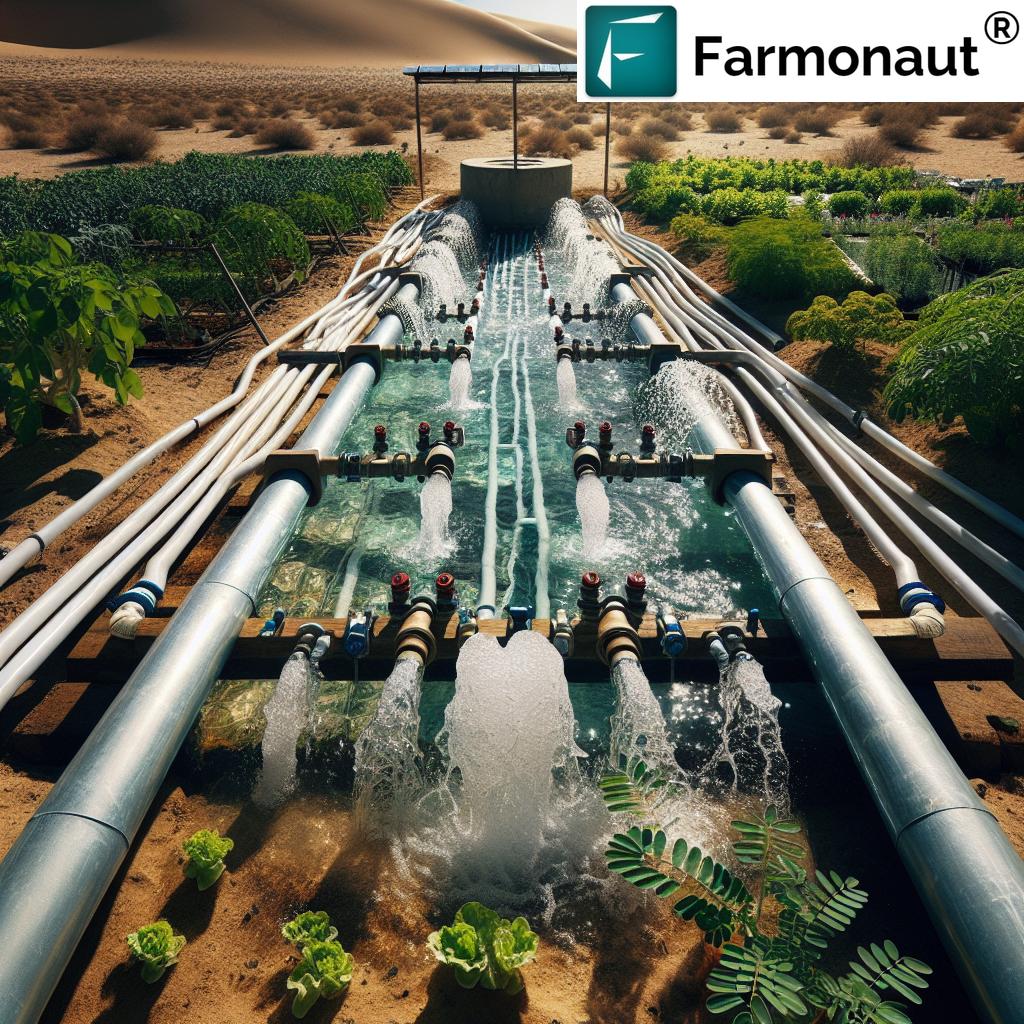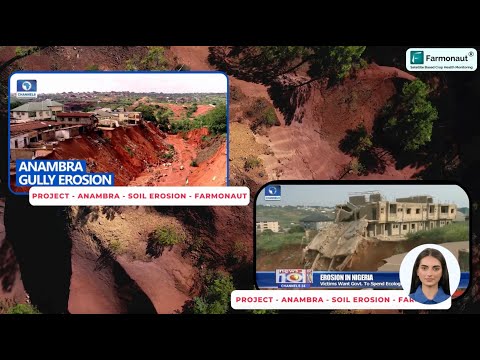Revolutionizing Sustainable Agriculture: Solar-Powered Gardens Combat Drought in Niger’s Diffa Region
“Niger’s 2-hectare solar-powered garden in Diffa region supports 100 families and 5 women’s cooperatives with year-round production.”
In the heart of Niger’s Diffa region, a remarkable transformation is taking place. We’re witnessing the dawn of a new era in sustainable agriculture, where innovative solar-powered gardens are breathing life into drought-stricken lands. This groundbreaking initiative is not just changing the landscape; it’s revolutionizing the way we approach farming in one of Africa’s most challenging agricultural environments.
As we delve into this inspiring story, we’ll explore how the integration of modern technology with traditional farming practices is creating a blueprint for rural development across arid regions. From drought-resistant farming techniques to solar-powered irrigation systems, we’re uncovering the secrets behind Niger’s agricultural renaissance.
The Challenge: Agriculture in Niger’s Arid Landscape
Niger’s Diffa region, nestled near the shores of Lake Chad, has long been a priority area for development assistance. The challenges faced by local communities are multifaceted:
- Acute drought conditions
- High population density
- Regional instability
- Disrupted livelihoods dependent on agriculture and livestock
These factors have created a perfect storm, threatening food security and economic stability for thousands of families. Traditional farming methods, once sufficient, now struggle to cope with the increasingly harsh climate.

The Solution: A 2-Hectare Oasis of Innovation
In response to these pressing issues, the Turkish Cooperation and Coordination Agency (TİKA) has spearheaded a groundbreaking project: a 2-hectare Vegetable and Moringa Production Garden. This initiative, located in N’Gourti, 300 kilometers from Diffa’s city center, is a testament to the power of collaboration and innovation in the face of adversity.
Key features of this solar-powered garden include:
- Water wells for reliable water access
- Solar energy systems for sustainable power
- Modern irrigation technologies, including California-type systems
- Year-round production capabilities
This project is more than just a garden; it’s a lifeline for approximately 100 families and five women’s cooperatives. By implementing climate-smart practices and providing essential resources like seeds, fertilizers, and tools, we’re fostering sustainable livelihoods in one of Africa’s most challenging regions.
Transforming Agriculture: From Traditional to Innovative
To truly appreciate the impact of this solar-powered garden, let’s compare it to traditional farming methods in the region:
| Aspect | Traditional Farming | Solar-Powered Garden |
|---|---|---|
| Water Usage (estimated liters/hectare/year) | 20,000,000 | 10,000,000 |
| Growing Season Duration (months) | 3-4 | 12 |
| Crop Diversity (number of varieties) | 2-3 | 10+ |
| Annual Yield (estimated kg/hectare) | 1,000 | 5,000 |
| Energy Source | Manual labor | Solar power |
| Drought Resistance | Low | High |
| Number of Beneficiaries | 20-30 families | 100+ families |
| Environmental Impact | High | Low |
| Initial Setup Costs (estimated) | $5,000 | $50,000 |
| Long-term Sustainability | Low | High |
This comparison highlights the transformative potential of sustainable agriculture in arid regions. The solar-powered garden not only increases productivity but also enhances resilience against climate challenges.
The Role of Technology in Sustainable Agriculture
At the heart of this agricultural revolution lies the innovative use of technology. Solar-powered irrigation systems are changing the game, allowing for efficient water management in desert farming. These systems, coupled with modern irrigation technologies, are the backbone of the garden’s success.
Key technological components include:
- Solar panels for energy generation
- Automated drip irrigation systems
- Soil moisture sensors
- Weather monitoring stations
These technologies work in harmony to create an ecosystem that maximizes productivity while minimizing resource use. The result is a sustainable, climate-resilient agricultural model that can be replicated across similar arid regions.
Empowering Communities Through Agriculture
The impact of this solar-powered garden extends far beyond crop yields. It’s a catalyst for community empowerment and social change. By focusing on women’s cooperatives, the project is promoting gender equality and economic independence.
Benefits to the community include:
- Increased food security
- Diversified income sources
- Skills development in modern farming techniques
- Strengthened social cohesion
This project exemplifies how sustainable agriculture can be a powerful tool for rural development, creating opportunities where once there were only challenges.
“A single solar-powered garden in Niger’s arid region can transform sustainable agriculture for an entire community of 100+ households.”
The Future of Farming in Arid Regions
As we look to the future, the success of this solar-powered garden in Niger’s Diffa region provides a blueprint for sustainable agriculture in similar climates worldwide. The project demonstrates that with the right combination of technology, community engagement, and sustainable practices, even the most challenging environments can become productive agricultural zones.
Key lessons for future projects:
- Invest in renewable energy sources
- Prioritize water-efficient irrigation systems
- Focus on crop diversification
- Engage and empower local communities
- Integrate traditional knowledge with modern techniques
By applying these principles, we can create resilient agricultural systems that not only survive but thrive in the face of climate change and environmental challenges.

The Role of Technology in Scaling Sustainable Agriculture
While the solar-powered garden in Niger’s Diffa region is a remarkable achievement, the potential for scaling such initiatives across Africa and beyond is immense. This is where cutting-edge agricultural technology companies like Farmonaut come into play.
Farmonaut offers advanced, satellite-based farm management solutions that can significantly enhance the efficiency and productivity of projects like the Diffa garden. Through its android, iOS, web/browser App, and API, Farmonaut provides valuable tools for precision agriculture that could be game-changers in arid regions.
Key Farmonaut technologies that could benefit similar projects include:
- Satellite-Based Crop Health Monitoring
- AI-driven personalized farm advisory
- Blockchain-based product traceability
- Fleet and resource management tools
- Carbon footprint tracking
These technologies can help farmers and agricultural projects in arid regions optimize their resource use, improve crop yields, and make data-driven decisions. By integrating such advanced solutions, projects like the Diffa garden could further enhance their impact and sustainability.
For more information on how Farmonaut’s technologies can support sustainable agriculture projects, visit their web app or explore their API.
Challenges and Opportunities
While the solar-powered garden in Niger’s Diffa region represents a significant step forward, it’s important to acknowledge the challenges that remain:
- Scaling the model to reach more communities
- Ensuring long-term maintenance of solar and irrigation systems
- Adapting to changing climate conditions
- Addressing regional security concerns
- Building local capacity for advanced agricultural techniques
However, these challenges also present opportunities for innovation and collaboration. By leveraging technologies like those offered by Farmonaut and fostering partnerships between local communities, governments, and international organizations, we can overcome these hurdles and create a more resilient agricultural future for arid regions.
The Ripple Effect: Beyond Agriculture
The impact of sustainable agriculture projects like the Diffa garden extends far beyond food production. These initiatives have the potential to transform entire communities and regions:
- Economic Growth: Increased agricultural productivity can stimulate local economies and create new job opportunities.
- Education: Successful farming projects can serve as educational hubs, teaching modern agricultural techniques to future generations.
- Health: Improved food security and diversified diets contribute to better health outcomes for communities.
- Environmental Conservation: Sustainable farming practices help preserve fragile ecosystems and combat desertification.
- Social Stability: By providing livelihoods and food security, these projects can contribute to regional stability and reduce conflict over resources.
As we continue to invest in and expand sustainable agriculture in arid regions, we’re not just growing crops; we’re cultivating hope, resilience, and prosperity for entire communities.
The Global Perspective: Lessons for Arid Regions Worldwide
The success of the solar-powered garden in Niger’s Diffa region offers valuable lessons for arid regions around the world. From the Sahel to the Middle East, and even parts of the American Southwest, the principles of sustainable agriculture demonstrated here can be adapted and applied.
Key takeaways for global implementation:
- Tailoring solutions to local conditions and needs
- Emphasizing community involvement and ownership
- Integrating traditional knowledge with modern technology
- Prioritizing water conservation and efficient irrigation
- Leveraging renewable energy sources, particularly solar power
- Focusing on crop diversification and climate-resilient varieties
By sharing knowledge and experiences across borders, we can accelerate the adoption of sustainable agricultural practices in arid regions worldwide, contributing to global food security and climate resilience.
The Role of Policy and Government Support
While innovative projects and technologies are crucial, the role of supportive policies and government involvement cannot be overstated. To truly revolutionize agriculture in arid regions, we need a conducive policy environment that:
- Encourages investment in sustainable agricultural technologies
- Provides incentives for adopting water-efficient irrigation systems
- Supports research and development in drought-resistant crop varieties
- Facilitates access to markets for small-scale farmers
- Promotes education and training in modern agricultural techniques
Governments, NGOs, and international organizations must work together to create an ecosystem that supports and nurtures sustainable agriculture initiatives like the Diffa garden.
Conclusion: A Green Revolution for Arid Lands
As we’ve explored throughout this article, the solar-powered garden in Niger’s Diffa region is more than just an agricultural project; it’s a beacon of hope and a model for sustainable development in some of the world’s most challenging environments. By combining innovative technologies, community engagement, and sustainable practices, we’re witnessing the birth of a new paradigm in arid land agriculture.
The success of this project demonstrates that with the right approach, even the most inhospitable environments can be transformed into productive, sustainable agricultural zones. As we look to the future, the lessons learned here will be invaluable in addressing global challenges of food security, climate change, and rural development.
By continuing to invest in and support initiatives like the Diffa garden, and by leveraging advanced technologies such as those offered by Farmonaut, we can create a future where sustainable agriculture thrives in arid regions, supporting communities, preserving ecosystems, and contributing to global food security.
The green revolution in Niger’s Diffa region is just the beginning. Together, we can cultivate a more sustainable, resilient, and prosperous future for arid lands around the world.
FAQ Section
Q: What makes the solar-powered garden in Niger’s Diffa region unique?
A: The garden combines solar energy, modern irrigation technologies, and drought-resistant farming techniques to create a sustainable agricultural model in an arid region. It supports 100 families and five women’s cooperatives, enabling year-round production.
Q: How does this project contribute to food security in the region?
A: By enabling year-round crop production and diversifying the types of crops grown, the project significantly enhances food availability and nutritional diversity for local communities, contributing to improved food security.
Q: Can this model be replicated in other arid regions?
A: Yes, the principles and technologies used in this project can be adapted and applied to other arid regions worldwide, offering a blueprint for sustainable agriculture in challenging environments.
Q: What role does technology play in this agricultural revolution?
A: Technology is crucial, from solar-powered irrigation systems to advanced crop monitoring tools. Companies like Farmonaut offer satellite-based farm management solutions that can further enhance the efficiency and productivity of such projects.
Q: How does this project empower local communities, especially women?
A: The project specifically supports women’s cooperatives, providing them with resources, training, and opportunities to engage in sustainable agriculture. This empowers women economically and socially within their communities.
Explore Farmonaut’s solutions:






